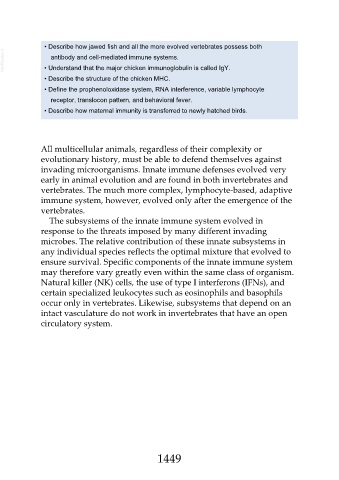Page 1449 - Veterinary Immunology, 10th Edition
P. 1449
• Describe how jawed fish and all the more evolved vertebrates possess both
VetBooks.ir • Understand that the major chicken immunoglobulin is called IgY.
antibody and cell-mediated immune systems.
• Describe the structure of the chicken MHC.
• Define the prophenoloxidase system, RNA interference, variable lymphocyte
receptor, translocon pattern, and behavioral fever.
• Describe how maternal immunity is transferred to newly hatched birds.
All multicellular animals, regardless of their complexity or
evolutionary history, must be able to defend themselves against
invading microorganisms. Innate immune defenses evolved very
early in animal evolution and are found in both invertebrates and
vertebrates. The much more complex, lymphocyte-based, adaptive
immune system, however, evolved only after the emergence of the
vertebrates.
The subsystems of the innate immune system evolved in
response to the threats imposed by many different invading
microbes. The relative contribution of these innate subsystems in
any individual species reflects the optimal mixture that evolved to
ensure survival. Specific components of the innate immune system
may therefore vary greatly even within the same class of organism.
Natural killer (NK) cells, the use of type I interferons (IFNs), and
certain specialized leukocytes such as eosinophils and basophils
occur only in vertebrates. Likewise, subsystems that depend on an
intact vasculature do not work in invertebrates that have an open
circulatory system.
1449

